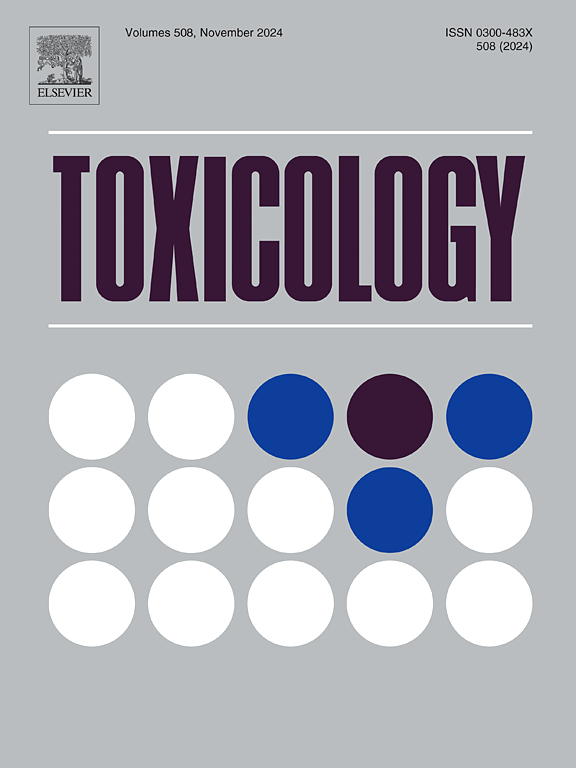Involvement of ARTS in bisphenol A-induced apoptosis of mouse Leydig cells
IF 4.6
3区 医学
Q1 PHARMACOLOGY & PHARMACY
引用次数: 0
Abstract
As a widely used organic chemical raw material in the world, bisphenol A (BPA) can induce apoptosis in mouse Leydig cells, yet the underlying mechanism remains insufficiently elucidated. Herein, we confirmed that BPA could induce apoptosis of TM3 cells, accompanied with the upregulation of apoptosis-related protein in the TGF-β signaling pathway (ARTS). Overexpression of ARTS promoted apoptosis of TM3 cells, while ARTS depletion attenuated BPA-induced apoptosis of the cells, indicating that ARTS plays a key role in BPA-induced apoptosis of mouse Leydig cells. Subsequently, BPA was found to increase the expression of transcription factor p53 in the cells. Interestingly, overexpression of p53 enhanced the expression of ARTS and induced apoptosis of TM3 cells, while knockdown of p53 by siRNA attenuated the upregulation of ARTS and the induction of apoptosis caused by BPA, implying that BPA induces apoptosis of mouse Leydig cells through p53/ARTS signals. In addition, we also found that oxidative stress was involved in BPA-induced apoptosis of TM3 cells through p53/ARTS signals. Taken together, these findings suggest that BPA-triggered oxidative stress activates p53/ARTS signaling pathway, thereby inducing apoptosis of mouse Leydig cells.
ARTS参与双酚a诱导的小鼠间质细胞凋亡
双酚a (BPA)是国际上广泛使用的有机化工原料,可诱导小鼠间质细胞凋亡,但其机制尚不清楚。本研究证实BPA可诱导TM3细胞凋亡,并伴有TGF-β信号通路(ARTS)中凋亡相关蛋白的上调。过表达ARTS可促进TM3细胞的凋亡,而缺失ARTS可减弱bpa诱导的细胞凋亡,提示ARTS在bpa诱导的小鼠间质细胞凋亡中起关键作用。随后,BPA被发现增加了细胞中转录因子p53的表达。有趣的是,过表达p53可增强ARTS的表达并诱导TM3细胞凋亡,而siRNA敲低p53可减弱BPA引起的ARTS上调及诱导凋亡,提示BPA通过p53/ARTS信号诱导小鼠间质细胞凋亡。此外,我们还发现氧化应激通过p53/ARTS信号参与bpa诱导的TM3细胞凋亡。综上所述,这些发现提示bpa触发的氧化应激激活p53/ARTS信号通路,从而诱导小鼠间质细胞凋亡。
本文章由计算机程序翻译,如有差异,请以英文原文为准。
求助全文
约1分钟内获得全文
求助全文
来源期刊

Toxicology
医学-毒理学
CiteScore
7.80
自引率
4.40%
发文量
222
审稿时长
23 days
期刊介绍:
Toxicology is an international, peer-reviewed journal that publishes only the highest quality original scientific research and critical reviews describing hypothesis-based investigations into mechanisms of toxicity associated with exposures to xenobiotic chemicals, particularly as it relates to human health. In this respect "mechanisms" is defined on both the macro (e.g. physiological, biological, kinetic, species, sex, etc.) and molecular (genomic, transcriptomic, metabolic, etc.) scale. Emphasis is placed on findings that identify novel hazards and that can be extrapolated to exposures and mechanisms that are relevant to estimating human risk. Toxicology also publishes brief communications, personal commentaries and opinion articles, as well as concise expert reviews on contemporary topics. All research and review articles published in Toxicology are subject to rigorous peer review. Authors are asked to contact the Editor-in-Chief prior to submitting review articles or commentaries for consideration for publication in Toxicology.
 求助内容:
求助内容: 应助结果提醒方式:
应助结果提醒方式:


